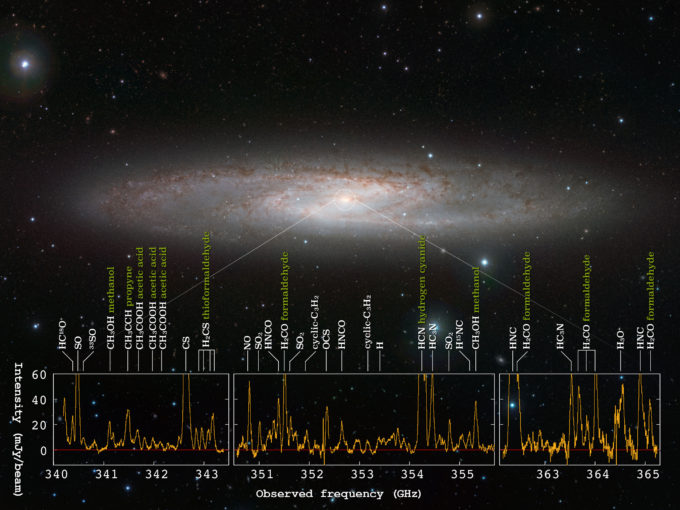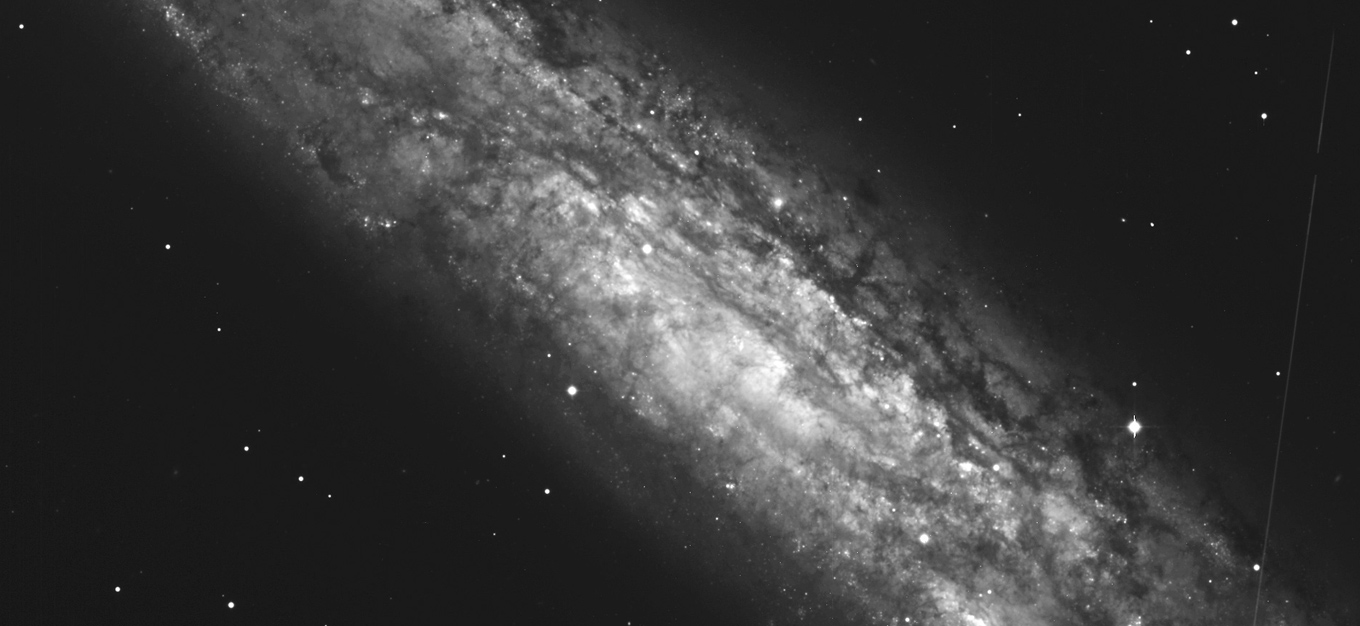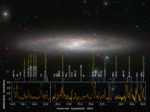Forest of Molecular Signals in Star Forming Galaxy
Astronomers found a rich molecular reservoir in the heart of an active star-forming galaxy with the Atacama Large Millimeter/submillimeter Array (ALMA). Among eight clouds identified at the center of the galaxy NGC 253, one exhibits very complex chemical composition, while in the other clouds many signals are missing. This chemical richness and diversity shed light on the nature of the baby boom galaxy.
Ryo Ando, a graduate student of the University of Tokyo, and his colleagues observed the galaxy NGC 253 and for the first time, they resolved the locations of star formation in this galaxy down to the scale of a molecular cloud, which is a star formation site with a size of about 30 light-years. As a result, they identified eight massive, dusty clouds aligned along the center of the galaxy.
“With its unprecedented resolution and sensitivity, ALMA showed us the detailed structure of the clouds,” said Ando, the lead author of the research paper published in the Astrophysical Journal. “To my surprise, the gas clouds have a strong chemical individuality despite their similarity in size and mass.”
Different molecules emit radio waves at different frequencies. Using this feature, the team investigated the chemical composition of the distant clouds by analyzing the radio signals precisely. They identified signals from various molecules including formaldehyde (H2CO), hydrogen cyanide (HCN), and many organic molecules.
One of the clouds stood out with its extremely rich chemical composition. The team identified footprints of 19 different molecules in the cloud, such as thioformaldehyde (H2CS), propyne (CH3CCH), and complex organic molecules including methanol (CH3OH) and acetic acid (CH3COOH). “The data are filled with the signals of various molecules,” said Ando. “It is like a forest of molecules.”
Many “molecular forests” have been found in our Milky Way Galaxy, but this is the first example outside the Milky Way. Researchers assume that the molecular jungle is an aggregate of dense and warm cocoons around bright baby stars. The cocoon gas is heated from inside by hundreds of young stars and a myriad of chemical reactions is driven to form various molecules.

The starburst galaxy NGC 253 and the radio spectra obtained with ALMA. ALMA detected radio signals from 19 different molecules at the center of this galaxy. Credit: ESO/J. Emerson/VISTA, ALMA (ESO/NAOJ/NRAO), Ando et al. Acknowledgment: Cambridge Astronomical Survey Unit
Interestingly, the number of chemical signals is different in different clouds. For example, another cloud among the eight has a very sparse chemical composition, even though it is located within dozens of light-years of the chemically rich cloud. Such a diverse nature of star forming clouds has never been seen before and could be a key to understanding the starburst process in this galaxy.
NGC 253 is a prototypical active star forming galaxy, or starburst galaxy. It is located 11 million light-years away in the constellation Sculptor. Starburst, or baby boom, galaxies have been the major drivers of star formation and galaxy evolution throughout the whole history of the Universe. Therefore it is crucial to understand what exactly is going on in the heart of such galaxies.
Paper and Research Team
These observation results were published as Ando et al. “Diverse nuclear star-forming activities in the heart of NGC 253 resolved with 10-pc-scale ALMA images” in the Astrophysical Journal in November 2017.
The research team members are:
Ryo Ando (The University of Tokyo), Kouichiro Nakanishi (National Astronomical Observatory of Japan/SOKENDAI), Kotaro Kohno (The University of Tokyo), Takuma Izumi (National Astronomical Observatory of Japan/The University of Tokyo), Sergio Martín (European Southern University/Joint ALMA Observatory), Nanase Harada (Academia Sinica Institute of Astronomy and Astrophysics), Shuro Takano (Nihon University), Nario Kuno (University of Tsukuba), Naomasa Nakai (University of Tsukuba), Hajime Sugai (The University of Tokyo), Kazuo Sorai (Hokkaido University), Tomoka Tosaki (Joetsu University of Education), Kazuya Matsubayashi (National Astronomical Observatory of Japan), Taku Nakajima (Nagoya University), Yuri Nishimura (The University of Tokyo/National Astronomical Observatory of Japan), and Yoichi Tamura (Nagoya University/The University of Tokyo)
This research was supported by the Japan Society for the Promotion of Science KAKENHI (Grant Number 15K05035 and 25247019).
Additional information
The Atacama Large Millimeter/submillimeter Array (ALMA), an international astronomy facility, is a partnership of the European Organisation for Astronomical Research in the Southern Hemisphere (ESO), the U.S. National Science Foundation (NSF) and the National Institutes of Natural Sciences (NINS) of Japan in cooperation with the Republic of Chile. ALMA is funded by ESO on behalf of its Member States, by NSF in cooperation with the National Research Council of Canada (NRC) and the Ministry of Science and Technology (MOST) in Taiwan and by NINS in cooperation with the Academia Sinica (AS) in Taiwan and the Korea Astronomy and Space Science Institute (KASI).
ALMA construction and operations are led by ESO on behalf of its Member States; by the National Radio Astronomy Observatory (NRAO), managed by Associated Universities, Inc. (AUI), on behalf of North America; and by the National Astronomical Observatory of Japan (NAOJ) on behalf of East Asia. The Joint ALMA Observatory (JAO) provides the unified leadership and management of the construction, commissioning and operation of ALMA.
Contacts
-
Valeria Foncea
Education and Public Outreach ManagerJoint ALMA Observatory Santiago - ChilePhone: +56 2 2467 6258Cel: +56 9 7587 1963Email: [email protected] -
Masaaki Hiramatsu
Education and Public Outreach Officer, NAOJ Chile -
Richard Hook
Public Information Officer, ESOGarching bei München, GermanyPhone: +49 89 3200 6655Cel: +49 151 1537 3591Email: [email protected] -
Charles E. Blue
Public Information OfficerNational Radio Astronomy Observatory Charlottesville, Virginia - USAPhone: +1 434 296 0314Cel: +1 202 236 6324Email: [email protected]

